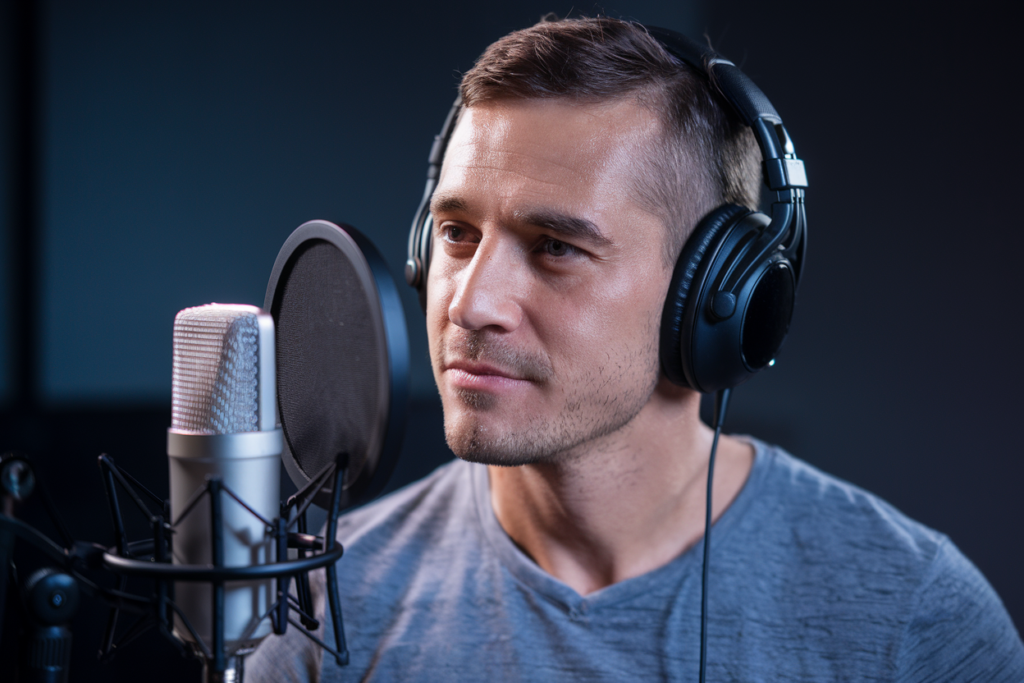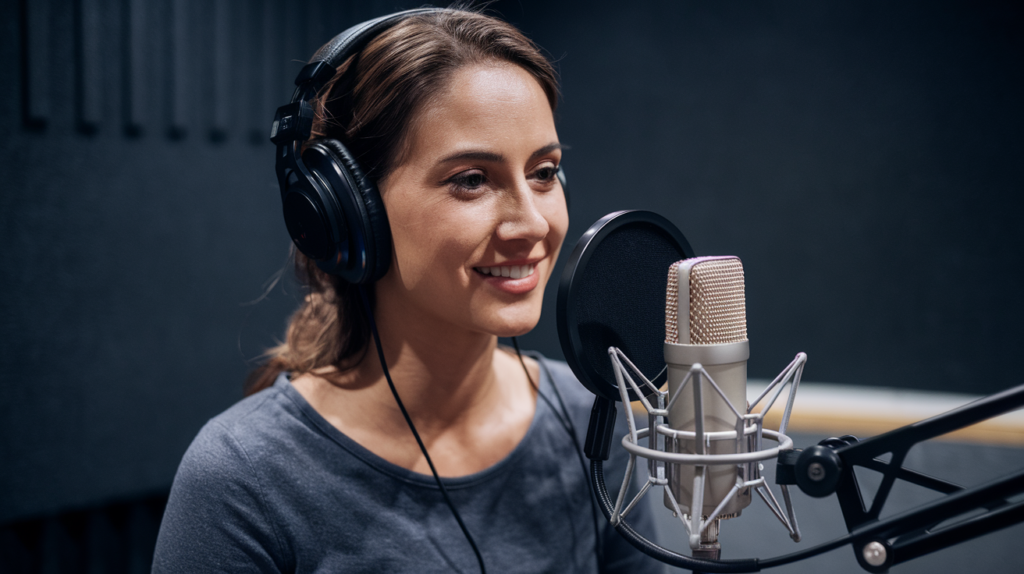Key Takeaways
- Understanding Voiceovers: Voiceovers are essential for enhancing narratives in films, commercials, and video games by adding depth and engagement to storytelling.
- Effective Direction is Key: Clear guidance and communication with voice talent ensure that the desired tone and emotion are effectively conveyed, leading to a stronger connection with the audience.
- Cultural Nuances Matter: Directing voiceovers in Romanian requires awareness of cultural expressions and emotional subtleties that can affect performance and audience perception.
- Technical Quality Is Crucial: Investing in high-quality recording equipment and conducting thorough technical checks can significantly improve audio clarity, enhancing the overall production quality.
- Foster Collaboration: Creating a collaborative environment encourages creativity among voice actors, resulting in more authentic performances that align with your vision.
- Overcome Challenges Proactively: Address potential language barriers and technical issues early on through clear communication and preparation to ensure smooth recording sessions.
Have you ever wondered how to effectively direct voiceovers in Romanian? Whether you’re working on a film, commercial, or video game, capturing the right tone and emotion can make all the difference. You want your project to resonate with the audience, and understanding the nuances of directing in Romanian is crucial.
Understanding Voiceovers
Voiceovers play a crucial role in bringing your projects to life. Whether it’s for film, commercials, or video games, the right voice can transform an ordinary narrative into something compelling and memorable.
The Importance of Voiceover Direction
Effective voiceover direction ensures that voice talent delivers exactly what you envision. Clear guidance helps voice artists capture the tone and emotion necessary for your project. Directing with precision allows you to connect with your audience on a deeper level, enhancing their overall experience. When you understand the nuances of directing in Romanian, you’re setting up both the voice actor and your project for success.
Key Elements of Successful Voiceover Work
Successful voiceover work hinges on several key elements:
- Clear Communication: Providing concise instructions helps voice actors grasp your vision quickly.
- Emotional Range: Ensuring that the chosen voice artist understands the emotional depth required can significantly impact delivery.
- Character Consistency: Maintaining consistency in character portrayal keeps narratives coherent across different scenes or segments.
- Technical Quality: Investing in quality recording equipment leads to clearer audio, which is vital for professional outcomes.
- Collaborative Spirit: Building a collaborative environment encourages creativity from both you and the talent involved.
By focusing on these elements, you create an atmosphere where effective collaboration thrives. Your approach to directing will ultimately shape how audiences perceive your message through powerful vocal performances.
Directing Voiceovers in Romanian
Directing voiceovers in Romanian requires a keen understanding of the language’s cultural nuances and emotional depth. This expertise ensures that the final product resonates with your audience, enhancing their connection to your project.
Cultural Nuances in Voice Direction
Understanding cultural context is key when directing voiceovers. The Romanian language carries unique expressions, idioms, and tones that reflect its rich heritage. Consider how certain phrases might evoke different emotions or reactions based on local customs. For instance, humor may translate well among younger audiences but could fall flat with older generations. Tailoring your direction to fit these cultural nuances not only respects the language but also enriches the performance of your voice talent.
Techniques for Effective Voiceovers
To achieve compelling results, utilize specific techniques during the recording process:
- Provide Clear Direction: Communicate exactly what you envision for each scene or line. Specify tone, pace, and emotion so that the voice actor can deliver precisely what you need.
- Encourage Emotional Range: Foster an environment where voice artists feel comfortable exploring various emotional depths. This flexibility often leads to more authentic performances.
- Maintain Character Consistency: Ensure that each character’s voice remains consistent throughout recordings. Discuss character backgrounds with your voice talent to help them embody their roles fully.
- Prioritize Technical Quality: Invest in high-quality recording equipment and a suitable studio space. Clean audio captures every nuance of a performance and minimizes distractions during playback.
- Promote Collaboration: Work closely with your team and the voice over artist throughout production. By fostering open communication channels, you create an atmosphere conducive to creativity.
Implementing these techniques will enhance both performance quality and audience engagement through powerful vocal interpretations in Romanian projects.
Challenges in Voiceover Direction
Directing voiceovers presents unique challenges that require careful navigation. Understanding these obstacles helps you create a more effective production process.
Language Barriers and Solutions
Language barriers often emerge when directing voice talent, especially in Romanian projects. Misinterpretations of tone or meaning can lead to performances that miss the mark. To overcome this, establish clear communication from the outset. Providing context and examples clarifies your vision for the voice artist, ensuring they grasp the intended emotion and nuance.
Encouraging open dialogue fosters collaboration between you and the voice actor. Ask questions about their interpretations and be receptive to feedback. This two-way street creates an environment where everyone feels comfortable expressing ideas, ultimately enhancing performance quality.
Technical Issues in Recording
Technical issues during recording can hinder even the best-directed sessions. Background noise, poor audio quality, or incorrect microphone placement disrupts clarity and focus. Ensuring high-quality equipment is essential for capturing optimal sound from your voice over talent.
Conduct thorough pre-session checks on all technical aspects. Test microphones and monitor levels to avoid surprises during recording. If problems arise, addressing them promptly allows for smoother sessions without losing momentum.
Being prepared also means having backup plans in place—whether it’s alternate locations for recording or extra equipment on hand—to ensure a seamless experience for both you and your voice artist.
Best Practices for Voiceover Directors
Effective voiceover direction significantly impacts the final product. Fostering a collaborative environment and leveraging technology leads to outstanding performances.
Collaboration with Voice Talents
Collaboration is essential in voiceover projects. Building rapport with your voice talent creates a comfortable atmosphere, allowing them to explore their character’s emotional range. Encourage open dialogue; this approach helps you communicate intentions clearly while inviting feedback from the voice artist. When they feel valued, they’ll give their best performance, enhancing your project’s overall quality.
Always provide specific direction rather than vague suggestions. Instead of saying «make it more energetic,» try something like «infuse excitement to match the scene’s intensity.» Tailoring your guidance fosters clarity and ensures that both you and the voice actor are on the same page.
Utilizing Technology in Voice Direction
Embracing technology streamlines the voiceover process and enhances creative possibilities. Use high-quality recording equipment to capture clear audio, as technical quality directly affects the audience’s experience. Consider employing software that allows for real-time monitoring of recordings; this enables immediate feedback and adjustments during sessions.
Incorporate digital tools for editing and sound design as well. Editing software provides options to adjust pacing or tone post-recording while ensuring seamless integration into your media project. Additionally, utilizing platforms for remote sessions can connect you with talented artists worldwide, expanding your selection of available voices.
By prioritizing collaboration and embracing cutting-edge technology, you create an effective framework for directing exceptional voiceovers that resonate deeply with audiences.
Conclusion
Directing voiceovers in Romanian is a nuanced skill that requires an understanding of both language and culture. By honing your techniques for clear communication and emotional depth, you can truly elevate the performances of voice talents. Prioritizing collaboration and utilizing technology will not only streamline the process but also enhance the quality of your project.
Embrace these strategies to create compelling narratives that resonate with your audience. The right direction can transform ordinary voiceovers into unforgettable experiences, making all the difference in how your message is received. Your commitment to excellence in this area will undoubtedly pay off in creating impactful media that stands out.
Frequently Asked Questions
What is the importance of voiceover direction in Romanian media projects?
Voiceover direction in Romanian media is crucial for capturing the right tone and emotion, which helps resonate with the audience. It transforms narratives into compelling stories by ensuring that voice talent delivers performances aligned with the director’s vision.
How does cultural context influence voiceover direction?
Cultural context plays a significant role in voiceover direction because unique expressions and idioms can evoke different emotions. Understanding local customs enhances emotional depth, allowing directors to connect more effectively with their audience.
What are key elements of successful voiceover work?
Key elements include clear communication, emotional range, character consistency, technical quality, and collaboration among team members. These factors contribute to high-quality performances that engage audiences effectively.
What challenges do directors face when directing Romanian voiceovers?
Directors may encounter language barriers leading to misinterpretations of tone or meaning. Establishing clear communication and providing context are essential to help voice artists grasp intended emotions accurately.
How can technology enhance the voiceover process?
Technology streamlines the recording process by using high-quality equipment for optimal sound clarity and real-time monitoring for immediate feedback. Digital tools also assist in editing and sound design, improving overall production quality.
Why is collaboration important in voiceover directing?
Collaboration creates a comfortable atmosphere where artists feel free to explore their characters’ emotional ranges. Building rapport allows for clearer direction and better performance quality from voice talents during sessions.







